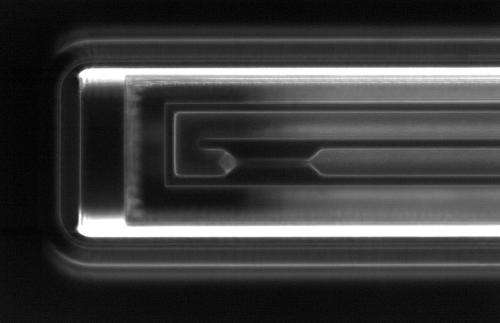A different view of cancer cells: New study measures physical changes in tumor cells as they become metastatic

Most cancer deaths are caused by metastatic tumors, which break free from the original cancer site and spread throughout the body. For that to happen, cancer cells must undergo many genetic and physical changes.
Many of those genetic changes have been studied extensively, but it has been more difficult to study the physical changes. Now, MIT researchers have developed a way to study three key physical properties of cancer cells—their mass, stiffness and friction—on a large scale.
Using this system, the researchers have analyzed how changes in those traits may allow cancer cells to migrate to new sites: Scientists have previously observed that cell lines with higher metastatic potential are generally more deformable, but the MIT team found that decreased friction also appears to help cancer cells traverse narrow channels, suggesting that friction may play a role in the ability of cancer cells to travel in blood vessels and reach new tumor sites.
"Our measurements provide an additional perspective on cell properties that may complement genomic and proteomic approaches," says Sangwon Byun, an MIT postdoc and lead author of a paper describing the findings in the Proceedings of the National Academy of Sciences the week of April 22.
The system that Byun and colleagues used to study the cancer cells is based on a device previously developed by Scott Manalis, a member of MIT's Koch Institute for Integrative Cancer Research and an MIT professor of biological engineering. Manalis, the senior author of the PNAS paper, has previously demonstrated that this system, known as a suspended microchannel resonator (SMR), can very accurately measure the mass and density of individual cells.
Inside the SMR, cells flow through a channel carved into a tiny slab that vibrates at a resonant frequency that can be measured with a laser beam. As each cell flows through the channel, the slab's resonant frequency changes, allowing the researchers to calculate the cell's mass and density.
Putting the squeeze on cells
For the new study, the researchers modified the system so they can also track each cell's velocity as it passes through a narrow constriction in the channel. This allows them to estimate both the cell's deformability and how much friction it experiences as it travels through the constriction, which is slightly smaller than the diameter of the cells under study. Cells that squeeze through this opening faster are more deformable.
In one set of experiments, the researchers compared the deformability of two types of mouse lung-cancer cells. The two cell types differ in the expression of only one transcription factor, known as NKX2-1: Cancer cells not expressing this factor are more aggressive and likely to metastasize. The researchers found that cells that do not express NKX2-1 entered the narrow channel more rapidly, confirming previous studies showing that metastatic cells are more deformable.
The researchers then compared nonmetastatic and metastatic cells from the same mouse model, and found that these metastatic cells were not only more deformable, but they also traveled faster through the length of the constriction (about 50 microns). A similar observation was made when comparing nonmetastatic to metastatic human lung-cancer cell lines. "It seems that the cells experience less friction, making it easier for them to get through the channels," Byun says.
This phenomenon has not been seen before, in part because scientists haven't had a good way to simultaneously define the size, deformability and friction of individual flowing cells. Many factors could influence the friction between the cell and the channel wall, including changes in cell-surface expression. For example, metastatic cancer cells often have an increased amount of sialic acid molecules on their surfaces, which may alter friction, the researchers say.
The new MIT system is "probably the world's most sensitive instrument for measuring a number of different biophysical properties of individual cells," says Mehmet Toner, a professor of biomedical engineering at Massachusetts General Hospital and Harvard Medical School who was not part of the research team. "It's very important to know whether metastatic cells have biophysical properties different than normal or nonmetastatic cancer cells, allowing them to go through narrow spaces."
Circulating tumor cells
The researchers are now using their system to detect circulating tumor cells (CTCs) in cancer patients' blood samples. The current approach to finding CTCs, which can range in number from a few to several thousand per milliliter of blood, is by looking for a marker (a molecule found on a cell's surface) that is preferentially expressed by epithelial cells. However, that approach may miss CTCs that don't express the chosen epithelial markers.
"When you use a specific marker to look for these cells, you find the cells that you're looking for, but you may be missing a whole population of cells," says Josephine Shaw, an MIT graduate student and a co-author of the paper. "It's possible that by using a more holistic and physical approach, we may be able to find certain cells that we wouldn't be able to find molecularly, because we wouldn't be able to guess ahead of time what these cells would be expressing."
Once those cells were captured, scientists could do many more types of tests on them, including analysis of genes expressed and proteins produced, to learn more about how they break free from tumors.
The researchers also plan to study physical changes that occur in cells as they go through the epithelial-mesenchymal transition—a process that allows cancer cells to lose their adhesion and become mobile, helping them metastasize.
This story is republished courtesy of MIT News (web.mit.edu/newsoffice/), a popular site that covers news about MIT research, innovation and teaching.














